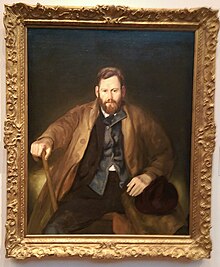Working on a hunch we reached out to Ursinus College in Allentown, Pennsylvania to see if they had any works by Francis Quirk. As it turned out, they had two chalk drawings. One is dated 1965 and is of an unknown gentleman. The other depicts the philanthropist Philip I. Berman who worked with his wife Muriel to support the arts in Pennsylvania. This drawing of Berman was included in an A to Z listing of works in the Ursinus collection. Given Berman's love of art, his donations to Lehigh, and now, this drawing their is little doubt that Quirk knew Berman well and had a relationship with him.
 |
| Portrait of Philip Berman by Francis J. Quirk Image Courtesy of Ursinus College |
 |
| Philip I. Berman Philanthropist Businessman |
 |
| Portrait of a man 1964 by Francis Quirk Image Courtesy of Ursinus College |
We include another chalk drawing of Quirk's for comparison purposes.
 |
| Francis J. Quirk Chalk Drawing Portrait of Smoking Man 1951 Image Courtesy of a Private Collector |
The Berman's business pursuits included the Fleetways trucking business which Philip Berman managed from 1965 to 1990, and Hess's department store which the Bermans bought in 1968. Hess's was an old Allentown institution and throve mightily under the Bermans, expanding from a single downtown store to a chain of seventeen stores in two states by the time the Bermans sold it in 1979. In 1975 Muriel Berman opened Hess's Fine Arts Gallery, where she exhibited and sold the work of first rate artists.
The Berman's were avid collectors with a wide variety of interests. Their personal collection would include works by many of the leading names in the modern art movement, from American masters such as Thomas Eakins to Gauguin, Matisse, Renoir and Picasso. The Bermans became a fixture in the art world, traveling through Europe and Israel personally negotiating the purchase of many of his artistic acquisitions. When asked why he bought so many works by each artist he responded with his retailer's philosophy, "If one is good, then 10 is better."
They numbered among their personal friends the artist Francoise Gilot, former mistress of Picasso and mother of Paloma Picasso. When Gilot married Jonas Salk, the inventor of the polio vaccine, she and Muriel Berman shopped for her wedding dress at Hess's.
They regaled their friends with stories of their visits to Henry Moore, whose sculptures occupy prominent positions in the Berman's personal sculpture garden, as well as to Alexander Calder and Marc Chagall.
Berman's list of donations to Museums is impressive. The first outright gift of art for public display may have been the gift of a painting, "Drifting Fog" by George M. Harding, to Lehigh University in 1959. The work has a coastal flavor to it as it includes sailboats and a lobster trap. The works of Harding were part of a Lehigh exhibition organized by Quirk in 1959 that also included works by Benton Spruance and Schilli Maier. This painting probably was a highlight from that show.
 |
| Morning Fog by George M. Harding Image courtesy of Lehigh University Art Gallery |
Major gifts of art followed to Ursinus College and Lehigh University as well as to several other colleges and universities in Pennsylvania and to the Philadelphia Museum of Art, where Philip Berman became Chairman of the Board of Trustees in 1989. At Ursinus College, to house their gifts of art, the Bermans established in 1984 the Philip and Muriel Berman Museum of Art.
 |
| George Matthews Harding American Painter |
George Matthews Harding (1882–1959) was an American painter, author-illustrator, and a muralist. Born into an artistic family in Philadelphia, Harding was particularly influenced by the art career of his older sister, Charlotte. Following in her footsteps, he studied at the Philadelphia Academy of Fine Arts, then with the distinguished illustrator-teacher Howard Pyle. In 1903 he began a successful career as an illustrator-author, which included international travel.
 |
| On the Trail of the Hun Aylward by George Matthews Harding |
After becoming America's first war artist, Harding was particularly intrigued by the new technologies of war. His war pictures are full of guns, airplanes, motorcycles, trucks, and tanks. He returned to American in February 1919 and before the end of the year published a lavish portfolio of his war art, The American Expeditionary Forces in Action.
In 1922, Harding became the head of the department of illustration at the Pennsylvania Academy of the Fine Arts, remaining at the school until his retirement in 1958. During World War II, at age 60, he was once again commissioned as an army captain and created war art in the South Pacific. He was the only AEF artist to serve in both wars.
His work was included in a few major group shows including "American Battle Painting 1776-1918" in 1944 and "Marines Under Fire" in 1943. Both were at New York's MOMA. In 1957 the Pennsylvania Academy of the Fine Arts would have a retrospective exhibition of his work.
Among his work was the murals in the Montgomery County Courthouse. You can read his writings about this work here. He also painted murals for several other Federal buildings including Post Offices as part of the WPA program.
 |
| Ben Franklin Colonial Postmaster- Mural by George Matthews Harding |

















